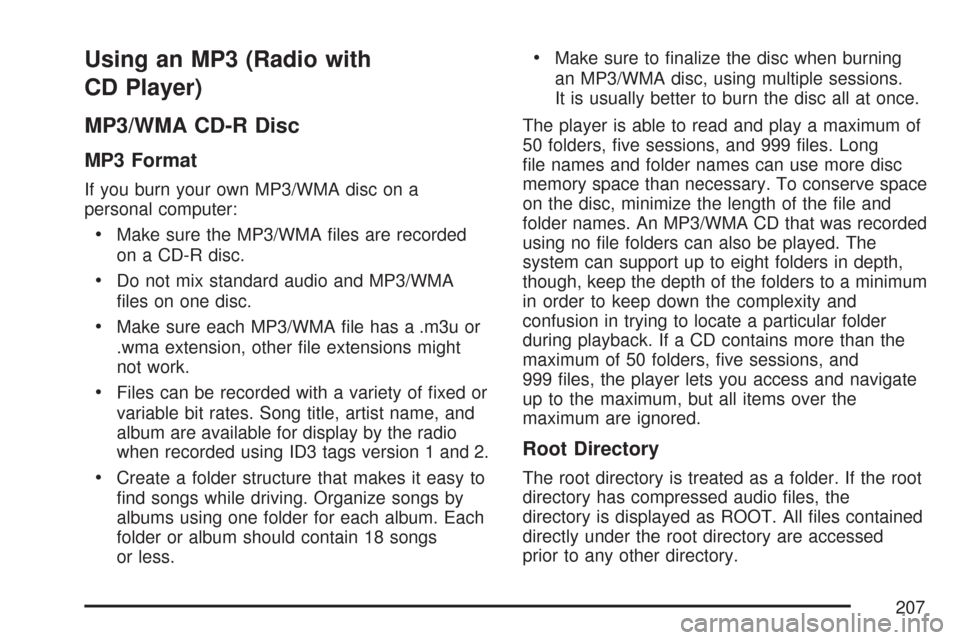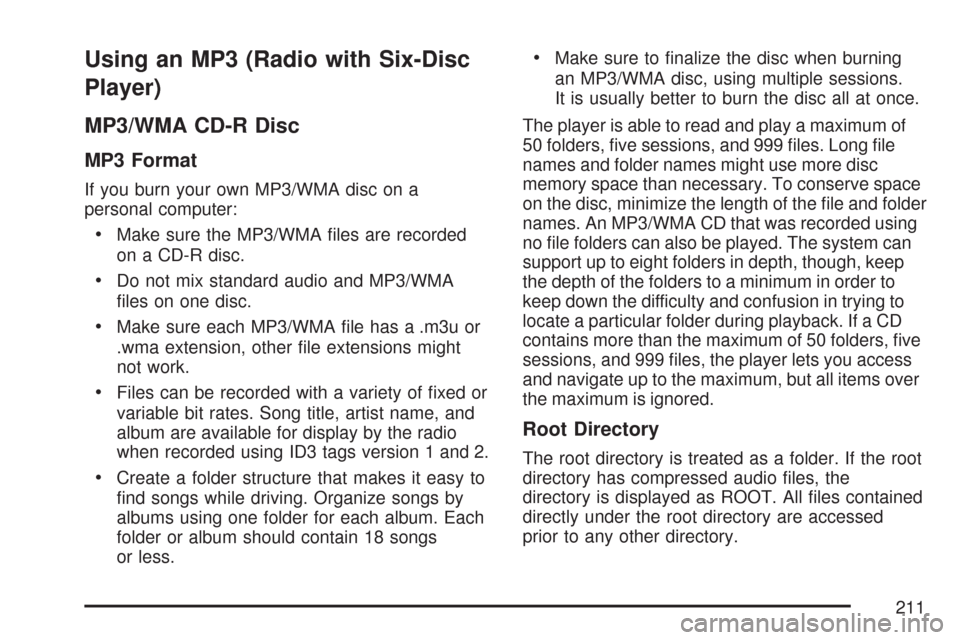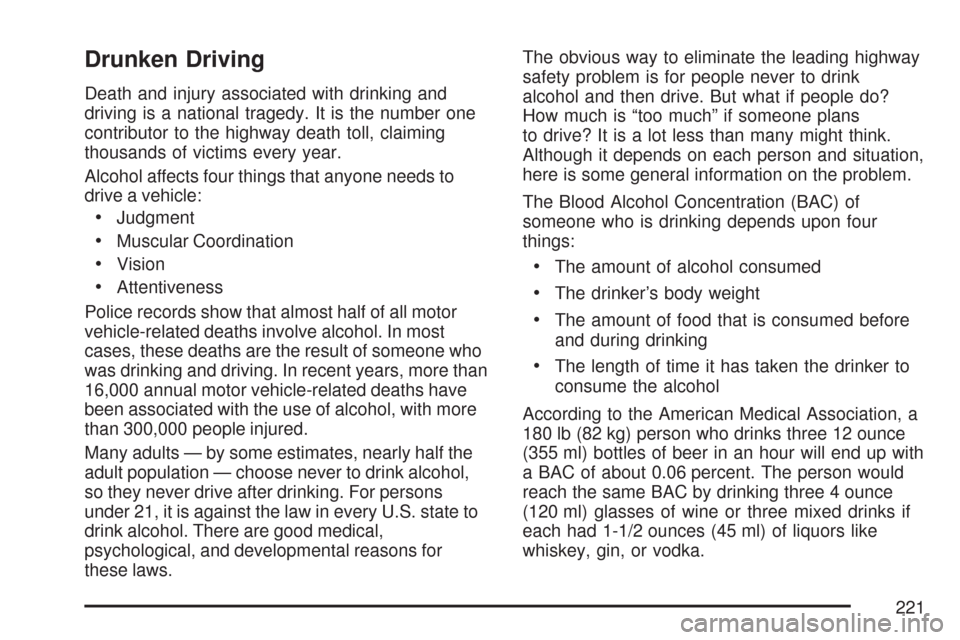Page 207 of 436

Using an MP3 (Radio with
CD Player)
MP3/WMA CD-R Disc
MP3 Format
If you burn your own MP3/WMA disc on a
personal computer:
•Make sure the MP3/WMA files are recorded
on a CD-R disc.
•Do not mix standard audio and MP3/WMA
files on one disc.
•Make sure each MP3/WMA file has a .m3u or
.wma extension, other file extensions might
not work.
•Files can be recorded with a variety of fixed or
variable bit rates. Song title, artist name, and
album are available for display by the radio
when recorded using ID3 tags version 1 and 2.
•Create a folder structure that makes it easy to
find songs while driving. Organize songs by
albums using one folder for each album. Each
folder or album should contain 18 songs
or less.
•Make sure to finalize the disc when burning
an MP3/WMA disc, using multiple sessions.
It is usually better to burn the disc all at once.
The player is able to read and play a maximum of
50 folders, five sessions, and 999 files. Long
file names and folder names can use more disc
memory space than necessary. To conserve space
on the disc, minimize the length of the file and
folder names. An MP3/WMA CD that was recorded
using no file folders can also be played. The
system can support up to eight folders in depth,
though, keep the depth of the folders to a minimum
in order to keep down the complexity and
confusion in trying to locate a particular folder
during playback. If a CD contains more than the
maximum of 50 folders, five sessions, and
999 files, the player lets you access and navigate
up to the maximum, but all items over the
maximum are ignored.
Root Directory
The root directory is treated as a folder. If the root
directory has compressed audio files, the
directory is displayed as ROOT. All files contained
directly under the root directory are accessed
prior to any other directory.
207
Page 211 of 436

Using an MP3 (Radio with Six-Disc
Player)
MP3/WMA CD-R Disc
MP3 Format
If you burn your own MP3/WMA disc on a
personal computer:
•Make sure the MP3/WMA files are recorded
on a CD-R disc.
•Do not mix standard audio and MP3/WMA
files on one disc.
•Make sure each MP3/WMA file has a .m3u or
.wma extension, other file extensions might
not work.
•Files can be recorded with a variety of fixed or
variable bit rates. Song title, artist name, and
album are available for display by the radio
when recorded using ID3 tags version 1 and 2.
•Create a folder structure that makes it easy to
find songs while driving. Organize songs by
albums using one folder for each album. Each
folder or album should contain 18 songs
or less.
•Make sure to finalize the disc when burning
an MP3/WMA disc, using multiple sessions.
It is usually better to burn the disc all at once.
The player is able to read and play a maximum of
50 folders, five sessions, and 999 files. Long file
names and folder names might use more disc
memory space than necessary. To conserve space
on the disc, minimize the length of the file and folder
names. An MP3/WMA CD that was recorded using
no file folders can also be played. The system can
support up to eight folders in depth, though, keep
the depth of the folders to a minimum in order to
keep down the difficulty and confusion in trying to
locate a particular folder during playback. If a CD
contains more than the maximum of 50 folders, five
sessions, and 999 files, the player lets you access
and navigate up to the maximum, but all items over
the maximum is ignored.
Root Directory
The root directory is treated as a folder. If the root
directory has compressed audio files, the
directory is displayed as ROOT. All files contained
directly under the root directory are accessed
prior to any other directory.
211
Page 221 of 436

Drunken Driving
Death and injury associated with drinking and
driving is a national tragedy. It is the number one
contributor to the highway death toll, claiming
thousands of victims every year.
Alcohol affects four things that anyone needs to
drive a vehicle:
•Judgment
•Muscular Coordination
•Vision
•Attentiveness
Police records show that almost half of all motor
vehicle-related deaths involve alcohol. In most
cases, these deaths are the result of someone who
was drinking and driving. In recent years, more than
16,000 annual motor vehicle-related deaths have
been associated with the use of alcohol, with more
than 300,000 people injured.
Many adults — by some estimates, nearly half the
adult population — choose never to drink alcohol,
so they never drive after drinking. For persons
under 21, it is against the law in every U.S. state to
drink alcohol. There are good medical,
psychological, and developmental reasons for
these laws.The obvious way to eliminate the leading highway
safety problem is for people never to drink
alcohol and then drive. But what if people do?
How much is “too much” if someone plans
to drive? It is a lot less than many might think.
Although it depends on each person and situation,
here is some general information on the problem.
The Blood Alcohol Concentration (BAC) of
someone who is drinking depends upon four
things:
•The amount of alcohol consumed
•The drinker’s body weight
•The amount of food that is consumed before
and during drinking
•The length of time it has taken the drinker to
consume the alcohol
According to the American Medical Association, a
180 lb (82 kg) person who drinks three 12 ounce
(355 ml) bottles of beer in an hour will end up with
a BAC of about 0.06 percent. The person would
reach the same BAC by drinking three 4 ounce
(120 ml) glasses of wine or three mixed drinks if
each had 1-1/2 ounces (45 ml) of liquors like
whiskey, gin, or vodka.
221